-
CentOS 6.4 x86_64
-
Nginx 1.4.2
|
1
2
3
|
[root@nginx ~]# rpm -ivh http://download.fedoraproject.org/pub/epel/6/x86_64/epel-release-6-8.noarch.rpm
[root@web1 ~]# rpm -ivh http://download.fedoraproject.org/pub/epel/6/x86_64/epel-release-6-8.noarch.rpm
[root@web2 ~]# rpm -ivh http://download.fedoraproject.org/pub/epel/6/x86_64/epel-release-6-8.noarch.rpm
|
|
1
2
3
|
[root@nginx ~]# ntpdate 202.120.2.101
[root@web1 ~]# ntpdate 202.120.2.101
[root@web2 ~]# ntpdate 202.120.2.101
|
|
1
2
3
4
5
6
7
8
9
10
11
12
|
[root@nginx ~]# service iptables stop
[root@nginx ~]# chkconfig iptables off
[root@nginx ~]# getenforce
Disabled[root@web1 ~]# service iptables stop
[root@web1 ~]# chkconfig iptables off
[root@web1 ~]# getenforce
Disabled[root@web2 ~]# service iptables stop
[root@web2 ~]# chkconfig iptables off
[root@web2 ~]# getenforce
Disabled |
|
1
|
[root@nginx src]# tar xf nginx-1.4.2.tar.gz
|
|
1
2
3
4
|
[root@nginx src]# groupadd -g 108 -r nginx
[root@nginx src]# useradd -u 108 -r -g 108 nginx
[root@nginx src]# id nginx
uid=108(nginx) gid=108(nginx) 组=108(nginx) |
|
1
2
|
[root@nginx src]# yum install -y pcre-devel openssl-devel
[root@nginx nginx-1.4.2]# ./configure --prefix=/usr --sbin-path=/usr/sbin/nginx --conf-path=/etc/nginx/nginx.conf --error-log-path=/var/log/nginx/error.log --http-log-path=/var/log/nginx/access.log --pid-path=/var/run/nginx/nginx.pid --lock-path=/var/lock/nginx.lock --user=nginx --group=nginx --with-http_ssl_module --with-http_flv_module --with-http_stub_status_module --with-http_gzip_static_module --http-client-body-temp-path=/var/tmp/nginx/client/ --http-proxy-temp-path=/var/tmp/nginx/proxy/ --http-fastcgi-temp-path=/var/tmp/nginx/fcgi/ --http-uwsgi-temp-path=/var/tmp/nginx/uwsgi --http-scgi-temp-path=/var/tmp/nginx/scgi --with-pcre
|
|
1
|
[root@nginx nginx-1.4.2]# make && make install
|
|
1
2
3
4
5
6
7
8
9
10
11
12
13
14
15
16
17
18
19
20
21
22
23
24
25
26
27
28
29
30
31
32
33
34
35
36
37
38
39
40
41
42
43
44
45
46
47
48
49
50
51
52
53
54
55
56
57
58
59
60
61
62
63
64
65
66
67
68
69
70
71
72
73
74
75
76
77
78
79
80
81
82
83
84
85
86
87
88
89
90
91
92
93
94
95
96
97
98
99
100
101
102
103
104
105
106
107
108
109
110
|
[root@nginx ~]# cat /etc/init.d/nginx
#!/bin/sh # # nginx - this script starts and stops the nginx daemon # # chkconfig: - 85 15 # description: Nginx is an HTTP(S) server, HTTP(S) reverse \ # proxy and IMAP/POP3 proxy server # processname: nginx # config: /etc/nginx/nginx.conf # config: /etc/sysconfig/nginx # pidfile: /var/run/nginx.pid # Source function library. . /etc/rc.d/init.d/functions # Source networking configuration. . /etc/sysconfig/network # Check that networking is up. [ "$NETWORKING" = "no" ] && exit 0
nginx="/usr/sbin/nginx" prog=$(basename $nginx)
NGINX_CONF_FILE="/etc/nginx/nginx.conf" [ -f /etc/sysconfig/nginx ] && . /etc/sysconfig/nginx lockfile=/var/lock/subsys/nginx make_dirs() { # make required directories
user=`nginx -V 2>&1 | grep "configure arguments:" | sed 's/[^*]*--user=\([^ ]*\).*/\1/g' -`
options=`$nginx -V 2>&1 | grep 'configure arguments:'`
for opt in $options; do if [ `echo $opt | grep '.*-temp-path'` ]; then value=`echo $opt | cut -d "=" -f 2`
if [ ! -d "$value" ]; then # echo "creating" $value
mkdir -p $value && chown -R $user $value
fi fi done } start() { [ -x $nginx ] || exit 5
[ -f $NGINX_CONF_FILE ] || exit 6
make_dirs
echo -n $"Starting $prog: " daemon $nginx -c $NGINX_CONF_FILE
retval=$?
echo [ $retval -eq 0 ] && touch $lockfile
return $retval
} stop() { echo -n $"Stopping $prog: " killproc $prog -QUIT
retval=$?
echo [ $retval -eq 0 ] && rm -f $lockfile
return $retval
} restart() { configtest || return $?
stop
sleep 1
start
} reload() { configtest || return $?
echo -n $"Reloading $prog: " killproc $nginx -HUP
RETVAL=$?
echo } force_reload() { restart
} configtest() { $nginx -t -c $NGINX_CONF_FILE
} rh_status() { status $prog
} rh_status_q() { rh_status >/dev/null 2>&1
} case "$1" in start)
rh_status_q && exit 0
$1
;;
stop)
rh_status_q || exit 0
$1
;;
restart|configtest)
$1
;;
reload)
rh_status_q || exit 7
$1
;;
force-reload)
force_reload
;;
status)
rh_status
;;
condrestart|try-restart)
rh_status_q || exit 0
;;
*)
echo $"Usage: $0 {start|stop|status|restart|condrestart|try-restart|reload|force-reload|configtest}" exit 2
esac |
|
1
|
[root@nginx ~]# chmod +x /etc/init.d/nginx
|
|
1
2
3
4
|
[root@nginx ~]# chkconfig --add nginx
[root@nginx ~]# chkconfig nginx on
[root@nginx ~]# chkconfig nginx --list
nginx 0:关闭 1:关闭 2:启用 3:启用 4:启用 5:启用 6:关闭 |
|
1
2
|
[root@nginx ~]# service nginx start
正在启动 nginx: [确定] |
|
1
2
|
[root@nginx ~]# netstat -ntlp | grep :80
tcp 0 0 0.0.0.0:80 0.0.0.0:* LISTEN 3889/nginx
|
|
1
2
|
[root@web1 ~]# yum install -y httpd
[root@web2 ~]# yum install -y httpd
|
|
1
2
|
[root@web1 ~]# echo "<h1>web1.test.com</h1>" > /var/www/html/index.html
[root@web2 ~]# echo "<h1>web2.test.com</h1>" > /var/www/html/index.html
|
|
1
2
3
4
|
[root@web1 ~]# service httpd start
正在启动 httpd: [确定][root@web2 ~]# service httpd start
正在启动 httpd: [确定] |
(1).正向代理的概念
正向代理,也就是传说中的代理,他的工作原理就像一个跳板,简单的说,我是一个用户,我访问不了某网站,但是我能访问一个代理服务器,这个代理服务器呢,他能访问那个我不能访问的网站,于是我先连上代理服务器,告诉他我需要那个无法访问网站的内容,代理服务器去取回来,然后返回给我。从网站的角度,只在代理服务器来取内容的时候有一次记录,有时候并不知道是用户的请求,也隐藏了用户的资料,这取决于代理告不告诉网站。
(2).反向代理的概念
(3).两者区别
|
1
2
3
4
|
location / { proxy_pass http://localhost:8000;
proxy_set_header X-Real-IP $remote_addr;
} |
|
1
2
3
4
5
6
|
[root@nginx ~]# cd /etc/nginx/
[root@nginx nginx]# cp nginx.conf nginx.conf.bak #备份一个原配置文件
[root@nginx nginx]# vim nginx.conf
location / { proxy_pass http://192.168.18.201;
}
|
|
1
2
3
4
|
[root@nginx ~]# service nginx reload
nginx: the configuration file /etc/nginx/nginx.conf syntax is ok
nginx: configuration file /etc/nginx/nginx.conf test is successful
重新载入 nginx: [确定] |
|
1
2
3
4
5
6
7
8
9
10
11
|
[root@web1 ~]# tail /var/log/httpd/access_log
192.168.18.208 - - [04/Sep/2013:00:14:20 +0800] "GET /favicon.ico HTTP/1.0" 404 289 "-" "Mozilla/5.0 (Windows NT 6.1; WOW64) AppleWebKit/537.36 (KHTML, like Gecko) Chrome/28.0.1500.95 Safari/537.36"
192.168.18.208 - - [04/Sep/2013:00:14:20 +0800] "GET / HTTP/1.0" 200 23 "-" "Mozilla/5.0 (Windows NT 6.1; WOW64) AppleWebKit/537.36 (KHTML, like Gecko) Chrome/28.0.1500.95 Safari/537.36"
192.168.18.208 - - [04/Sep/2013:00:14:20 +0800] "GET /favicon.ico HTTP/1.0" 404 289 "-" "Mozilla/5.0 (Windows NT 6.1; WOW64) AppleWebKit/537.36 (KHTML, like Gecko) Chrome/28.0.1500.95 Safari/537.36"
192.168.18.138 - - [04/Sep/2013:00:14:45 +0800] "GET / HTTP/1.1" 200 23 "-" "Mozilla/5.0 (Windows NT 6.1; WOW64) AppleWebKit/537.36 (KHTML, like Gecko) Chrome/28.0.1500.95 Safari/537.36"
192.168.18.138 - - [04/Sep/2013:00:14:48 +0800] "GET /favicon.ico HTTP/1.1" 404 289 "-" "Mozilla/5.0 (Windows NT 6.1; WOW64) AppleWebKit/537.36 (KHTML, like Gecko) Chrome/28.0.1500.95 Safari/537.36"
192.168.18.208 - - [04/Sep/2013:00:14:55 +0800] "GET /favicon.ico HTTP/1.0" 404 289 "-" "Mozilla/5.0 (Windows NT 6.1; WOW64) AppleWebKit/537.36 (KHTML, like Gecko) Chrome/28.0.1500.95 Safari/537.36"
192.168.18.208 - - [04/Sep/2013:00:15:05 +0800] "GET /favicon.ico HTTP/1.0" 404 289 "-" "Mozilla/5.0 (Windows NT 6.1; WOW64) AppleWebKit/537.36 (KHTML, like Gecko) Chrome/28.0.1500.95 Safari/537.36"
192.168.18.208 - - [04/Sep/2013:00:15:13 +0800] "GET /favicon.ico HTTP/1.0" 404 289 "-" "Mozilla/5.0 (Windows NT 6.1; WOW64) AppleWebKit/537.36 (KHTML, like Gecko) Chrome/28.0.1500.95 Safari/537.36"
192.168.18.208 - - [04/Sep/2013:00:15:16 +0800] "GET / HTTP/1.0" 200 23 "-" "Mozilla/5.0 (Windows NT 6.1; WOW64) AppleWebKit/537.36 (KHTML, like Gecko) Chrome/28.0.1500.95 Safari/537.36"
192.168.18.208 - - [04/Sep/2013:00:15:16 +0800] "GET /favicon.ico HTTP/1.0" 404 289 "-" "Mozilla/5.0 (Windows NT 6.1; WOW64) AppleWebKit/537.36 (KHTML, like Gecko) Chrome/28.0.1500.95 Safari/537.36"
|
|
1
2
3
4
|
location / { proxy_pass http://192.168.18.201;
proxy_set_header X-Real-IP $remote_addr; #加上这一行
} |
|
1
2
3
4
|
[root@nginx ~]# service nginx reload
nginx: the configuration file /etc/nginx/nginx.conf syntax is ok
nginx: configuration file /etc/nginx/nginx.conf test is successful
重新载入 nginx: [确定] |
|
1
2
3
4
5
6
7
8
9
10
11
|
[root@web1 ~]# tail /var/log/httpd/access_log
192.168.18.208 - - [03/Sep/2013:16:26:18 +0800] "GET / HTTP/1.0" 200 23 "-" "Mozilla/5.0 (compatible; MSIE 10.0; Windows NT 6.1; WOW64; Trident/6.0)"
192.168.18.208 - - [03/Sep/2013:16:26:18 +0800] "GET / HTTP/1.0" 200 23 "-" "Mozilla/5.0 (compatible; MSIE 10.0; Windows NT 6.1; WOW64; Trident/6.0)"
192.168.18.208 - - [03/Sep/2013:16:26:18 +0800] "GET / HTTP/1.0" 200 23 "-" "Mozilla/5.0 (compatible; MSIE 10.0; Windows NT 6.1; WOW64; Trident/6.0)"
192.168.18.208 - - [03/Sep/2013:16:26:18 +0800] "GET / HTTP/1.0" 200 23 "-" "Mozilla/5.0 (compatible; MSIE 10.0; Windows NT 6.1; WOW64; Trident/6.0)"
192.168.18.208 - - [03/Sep/2013:16:26:18 +0800] "GET / HTTP/1.0" 200 23 "-" "Mozilla/5.0 (compatible; MSIE 10.0; Windows NT 6.1; WOW64; Trident/6.0)"
192.168.18.208 - - [03/Sep/2013:16:26:18 +0800] "GET / HTTP/1.0" 200 23 "-" "Mozilla/5.0 (compatible; MSIE 10.0; Windows NT 6.1; WOW64; Trident/6.0)"
192.168.18.208 - - [03/Sep/2013:16:26:18 +0800] "GET / HTTP/1.0" 200 23 "-" "Mozilla/5.0 (compatible; MSIE 10.0; Windows NT 6.1; WOW64; Trident/6.0)"
192.168.18.208 - - [03/Sep/2013:16:26:18 +0800] "GET / HTTP/1.0" 200 23 "-" "Mozilla/5.0 (compatible; MSIE 10.0; Windows NT 6.1; WOW64; Trident/6.0)"
192.168.18.208 - - [03/Sep/2013:16:26:18 +0800] "GET / HTTP/1.0" 200 23 "-" "Mozilla/5.0 (compatible; MSIE 10.0; Windows NT 6.1; WOW64; Trident/6.0)"
192.168.18.208 - - [03/Sep/2013:16:26:18 +0800] "GET / HTTP/1.0" 200 23 "-" "Mozilla/5.0 (compatible; MSIE 10.0; Windows NT 6.1; WOW64; Trident/6.0)"
|
|
1
2
3
4
5
6
7
8
9
10
11
12
13
14
|
[root@web1 ~]# service httpd restart
停止 httpd: [确定]正在启动 httpd: [确定][root@web1 ~]# tail /var/log/httpd/access_log
192.168.18.138 - - [03/Sep/2013:17:09:14 +0800] "GET / HTTP/1.0" 200 23 "-" "Mozilla/5.0 (compatible; MSIE 10.0; Windows NT 6.1; WOW64; Trident/6.0)"
192.168.18.138 - - [03/Sep/2013:17:09:14 +0800] "GET / HTTP/1.0" 200 23 "-" "Mozilla/5.0 (compatible; MSIE 10.0; Windows NT 6.1; WOW64; Trident/6.0)"
192.168.18.138 - - [03/Sep/2013:17:09:15 +0800] "GET / HTTP/1.0" 200 23 "-" "Mozilla/5.0 (compatible; MSIE 10.0; Windows NT 6.1; WOW64; Trident/6.0)"
192.168.18.138 - - [03/Sep/2013:17:09:15 +0800] "GET / HTTP/1.0" 200 23 "-" "Mozilla/5.0 (compatible; MSIE 10.0; Windows NT 6.1; WOW64; Trident/6.0)"
192.168.18.138 - - [03/Sep/2013:17:09:15 +0800] "GET / HTTP/1.0" 200 23 "-" "Mozilla/5.0 (compatible; MSIE 10.0; Windows NT 6.1; WOW64; Trident/6.0)"
192.168.18.138 - - [03/Sep/2013:17:09:15 +0800] "GET / HTTP/1.0" 200 23 "-" "Mozilla/5.0 (compatible; MSIE 10.0; Windows NT 6.1; WOW64; Trident/6.0)"
192.168.18.138 - - [03/Sep/2013:17:09:15 +0800] "GET / HTTP/1.0" 200 23 "-" "Mozilla/5.0 (compatible; MSIE 10.0; Windows NT 6.1; WOW64; Trident/6.0)"
192.168.18.138 - - [03/Sep/2013:17:09:15 +0800] "GET / HTTP/1.0" 200 23 "-" "Mozilla/5.0 (compatible; MSIE 10.0; Windows NT 6.1; WOW64; Trident/6.0)"
192.168.18.138 - - [03/Sep/2013:17:09:15 +0800] "GET / HTTP/1.0" 200 23 "-" "Mozilla/5.0 (compatible; MSIE 10.0; Windows NT 6.1; WOW64; Trident/6.0)"
192.168.18.138 - - [03/Sep/2013:17:09:15 +0800] "GET / HTTP/1.0" 200 23 "-" "Mozilla/5.0 (compatible; MSIE 10.0; Windows NT 6.1; WOW64; Trident/6.0)"
|
|
1
2
3
4
5
6
7
8
9
10
11
12
|
upstream test.net{
ip_hash;server 192.168.10.13:80;server 192.168.10.14:80 down;server 192.168.10.15:8009 max_fails=3 fail_timeout=20s;server 192.168.10.16:8080;}server { location / {
proxy_pass http://test.net;
}
} |
-
轮询(默认)。每个请求按时间顺序逐一分配到不同的后端服务器,如果后端某台服务器宕机,故障系统被自动剔除,使用户访问不受影响。Weight 指定轮询权值,Weight值越大,分配到的访问机率越高,主要用于后端每个服务器性能不均的情况下。
-
ip_hash。每个请求按访问IP的hash结果分配,这样来自同一个IP的访客固定访问一个后端服务器,有效解决了动态网页存在的session共享问题。
-
fair。这是比上面两个更加智能的负载均衡算法。此种算法可以依据页面大小和加载时间长短智能地进行负载均衡,也就是根据后端服务器的响应时间来分配请求,响应时间短的优先分配。Nginx本身是不支持fair的,如果需要使用这种调度算法,必须下载Nginx的upstream_fair模块。
-
url_hash。此方法按访问url的hash结果来分配请求,使每个url定向到同一个后端服务器,可以进一步提高后端缓存服务器的效率。Nginx本身是不支持url_hash的,如果需要使用这种调度算法,必须安装Nginx 的hash软件包。
-
down,表示当前的server暂时不参与负载均衡。
-
backup,预留的备份机器。当其他所有的非backup机器出现故障或者忙的时候,才会请求backup机器,因此这台机器的压力最轻。
-
max_fails,允许请求失败的次数,默认为1。当超过最大次数时,返回proxy_next_upstream 模块定义的错误。
-
fail_timeout,在经历了max_fails次失败后,暂停服务的时间。max_fails可以和fail_timeout一起使用。
|
1
2
3
4
5
6
7
8
9
10
11
12
13
14
15
|
[root@nginx ~]# vim /etc/nginx/nginx.conf
upstream webservers { server 192.168.18.201 weight=1;
server 192.168.18.202 weight=1;
}
server {
listen 80;
server_name localhost;
#charset koi8-r;
#access_log logs/host.access.log main;
location / {
proxy_pass http://webservers;
proxy_set_header X-Real-IP $remote_addr;
}
} |
|
1
2
3
4
|
[root@nginx ~]# service nginx reload
nginx: the configuration file /etc/nginx/nginx.conf syntax is ok
nginx: configuration file /etc/nginx/nginx.conf test is successful
重新载入 nginx: [确定] |
|
1
2
3
4
5
6
7
8
9
10
11
|
[root@web1 ~]# tail /var/log/httpd/access_log
192.168.18.138 - - [04/Sep/2013:09:41:58 +0800] "GET / HTTP/1.0" 200 23 "-" "Mozilla/5.0 (compatible; MSIE 10.0; Windows NT 6.1; WOW64; Trident/6.0)"
192.168.18.138 - - [04/Sep/2013:09:41:58 +0800] "GET / HTTP/1.0" 200 23 "-" "Mozilla/5.0 (compatible; MSIE 10.0; Windows NT 6.1; WOW64; Trident/6.0)"
192.168.18.138 - - [04/Sep/2013:09:41:59 +0800] "GET / HTTP/1.0" 200 23 "-" "Mozilla/5.0 (compatible; MSIE 10.0; Windows NT 6.1; WOW64; Trident/6.0)"
192.168.18.138 - - [04/Sep/2013:09:41:59 +0800] "GET / HTTP/1.0" 200 23 "-" "Mozilla/5.0 (compatible; MSIE 10.0; Windows NT 6.1; WOW64; Trident/6.0)"
192.168.18.138 - - [04/Sep/2013:09:42:00 +0800] "GET / HTTP/1.0" 200 23 "-" "Mozilla/5.0 (compatible; MSIE 10.0; Windows NT 6.1; WOW64; Trident/6.0)"
192.168.18.138 - - [04/Sep/2013:09:42:00 +0800] "GET / HTTP/1.0" 200 23 "-" "Mozilla/5.0 (compatible; MSIE 10.0; Windows NT 6.1; WOW64; Trident/6.0)"
192.168.18.138 - - [04/Sep/2013:09:42:00 +0800] "GET / HTTP/1.0" 200 23 "-" "Mozilla/5.0 (compatible; MSIE 10.0; Windows NT 6.1; WOW64; Trident/6.0)"
192.168.18.138 - - [04/Sep/2013:09:44:21 +0800] "GET / HTTP/1.0" 200 23 "-" "Mozilla/5.0 (compatible; MSIE 10.0; Windows NT 6.1; WOW64; Trident/6.0)"
192.168.18.138 - - [04/Sep/2013:09:44:22 +0800] "GET / HTTP/1.0" 200 23 "-" "Mozilla/5.0 (compatible; MSIE 10.0; Windows NT 6.1; WOW64; Trident/6.0)"
192.168.18.138 - - [04/Sep/2013:09:44:22 +0800] "GET / HTTP/1.0" 200 23 "-" "Mozilla/5.0 (compatible; MSIE 10.0; Windows NT 6.1; WOW64; Trident/6.0)"
|
|
1
2
3
4
5
|
[root@web2 ~]# vim /etc/httpd/conf/httpd.conf
LogFormat "%{X-Real-IP}i %l %u %t \"%r\" %>s %b \"%{Referer}i\" \"%{User-Agent}i\"" combined
[root@web2 ~]# service httpd restart
停止 httpd: [确定]正在启动 httpd: [确定] |
|
1
2
3
4
5
6
7
8
9
10
11
|
[root@web2 ~]# tail /var/log/httpd/access_log
192.168.18.138 - - [04/Sep/2013:09:50:28 +0800] "GET / HTTP/1.0" 200 23 "-" "Mozilla/5.0 (compatible; MSIE 10.0; Windows NT 6.1; WOW64; Trident/6.0)"
192.168.18.138 - - [04/Sep/2013:09:50:28 +0800] "GET / HTTP/1.0" 200 23 "-" "Mozilla/5.0 (compatible; MSIE 10.0; Windows NT 6.1; WOW64; Trident/6.0)"
192.168.18.138 - - [04/Sep/2013:09:50:28 +0800] "GET / HTTP/1.0" 200 23 "-" "Mozilla/5.0 (compatible; MSIE 10.0; Windows NT 6.1; WOW64; Trident/6.0)"
192.168.18.138 - - [04/Sep/2013:09:50:28 +0800] "GET / HTTP/1.0" 200 23 "-" "Mozilla/5.0 (compatible; MSIE 10.0; Windows NT 6.1; WOW64; Trident/6.0)"
192.168.18.138 - - [04/Sep/2013:09:50:28 +0800] "GET / HTTP/1.0" 200 23 "-" "Mozilla/5.0 (compatible; MSIE 10.0; Windows NT 6.1; WOW64; Trident/6.0)"
192.168.18.138 - - [04/Sep/2013:09:50:28 +0800] "GET / HTTP/1.0" 200 23 "-" "Mozilla/5.0 (compatible; MSIE 10.0; Windows NT 6.1; WOW64; Trident/6.0)"
192.168.18.138 - - [04/Sep/2013:09:50:28 +0800] "GET / HTTP/1.0" 200 23 "-" "Mozilla/5.0 (compatible; MSIE 10.0; Windows NT 6.1; WOW64; Trident/6.0)"
192.168.18.138 - - [04/Sep/2013:09:50:28 +0800] "GET / HTTP/1.0" 200 23 "-" "Mozilla/5.0 (compatible; MSIE 10.0; Windows NT 6.1; WOW64; Trident/6.0)"
192.168.18.138 - - [04/Sep/2013:09:50:29 +0800] "GET / HTTP/1.0" 200 23 "-" "Mozilla/5.0 (compatible; MSIE 10.0; Windows NT 6.1; WOW64; Trident/6.0)"
192.168.18.138 - - [04/Sep/2013:09:50:29 +0800] "GET / HTTP/1.0" 200 23 "-" "Mozilla/5.0 (compatible; MSIE 10.0; Windows NT 6.1; WOW64; Trident/6.0)"
|
-
max_fails,允许请求失败的次数,默认为1。当超过最大次数时,返回proxy_next_upstream 模块定义的错误。
-
fail_timeout,在经历了max_fails次失败后,暂停服务的时间。max_fails可以和fail_timeout一起使用,进行健康状态检查。
|
1
2
3
4
5
|
[root@nginx ~]# vim /etc/nginx/nginx.conf
upstream webservers { server 192.168.18.201 weight=1 max_fails=2 fail_timeout=2;
server 192.168.18.202 weight=1 max_fails=2 fail_timeout=2;
}
|
|
1
2
3
4
|
[root@nginx ~]# service nginx reload
nginx: the configuration file /etc/nginx/nginx.conf syntax is ok
nginx: configuration file /etc/nginx/nginx.conf test is successful
重新载入 nginx: [确定] |
|
1
2
3
|
先停止Web1,进行测试。[root@web1 ~]# service httpd stop
停止 httpd: [确定] |
|
1
2
|
[root@web1 ~]# service httpd start
正在启动 httpd: [确定] |
|
1
2
3
4
5
6
7
8
9
10
11
12
13
14
15
|
[root@nginx ~]# vim /etc/nginx/nginx.conf
server { listen 8080;
server_name localhost;
root /data/www/errorpage;
index index.html;
}
upstream webservers { server 192.168.18.201 weight=1 max_fails=2 fail_timeout=2;
server 192.168.18.202 weight=1 max_fails=2 fail_timeout=2;
server 127.0.0.1:8080 backup;
}
[root@nginx ~]# mkdir -pv /data/www/errorpage
[root@nginx errorpage]# cat index.html
<h1>Sorry......</h1>
|
|
1
2
3
4
|
[root@nginx errorpage]# service nginx reload
nginx: the configuration file /etc/nginx/nginx.conf syntax is ok
nginx: configuration file /etc/nginx/nginx.conf test is successful
重新载入 nginx: [确定] |
|
1
2
3
4
|
[root@web1 ~]# service httpd stop
停止 httpd: [确定][root@web2 ~]# service httpd stop
停止 httpd: [确定] |
-
ip_hash,每个请求按访问IP的hash结果分配,这样来自同一个IP的访客固定访问一个后端服务器,有效解决了动态网页存在的session共享问题。(一般电子商务网站用的比较多)
|
1
2
3
4
5
6
7
|
[root@nginx ~]# vim /etc/nginx/nginx.conf
upstream webservers { ip_hash;
server 192.168.18.201 weight=1 max_fails=2 fail_timeout=2;
server 192.168.18.202 weight=1 max_fails=2 fail_timeout=2;
#server 127.0.0.1:8080 backup;
}
|
|
1
2
3
4
|
[root@nginx ~]# service nginx reload
nginx: the configuration file /etc/nginx/nginx.conf syntax is ok
nginx: configuration file /etc/nginx/nginx.conf test is successful
重新载入 nginx: [确定] |
|
1
2
|
[root@web2 ~]# netstat -an | grep :80 | wc -l
304 |
proxy_cache_path
|
1
|
proxy_cache_path /data/nginx/cache levels=1:2 keys_zone=one:10m;
|
|
1
|
/data/nginx/cache/c/29/b7f54b2df7773722d382f4809d65029c |
|
1
2
3
|
proxy_cache_path /data/nginx/cache/one levels=1 keys_zone=one:10m;
proxy_cache_path /data/nginx/cache/two levels=2:2 keys_zone=two:100m;
proxy_cache_path /data/nginx/cache/three levels=1:1:2 keys_zone=three:1000m;
|
proxy_cache
proxy_cache_valid
|
1
2
|
proxy_cache_valid 200 302 10m;proxy_cache_valid 404 1m; |
|
1
|
proxy_cache_valid 5m; |
|
1
2
3
|
proxy_cache_valid 200 302 10m;proxy_cache_valid 301 1h;proxy_cache_valid any 1m; |
|
1
2
3
4
5
6
7
8
9
10
11
12
13
14
|
[root@nginx ~]# vim /etc/nginx/nginx.conf
proxy_cache_path /data/nginx/cache/webserver levels=1:2 keys_zone=webserver:20m max_size=1g;
server {
listen 80;
server_name localhost;
#charset koi8-r;
#access_log logs/host.access.log main;
location / {
proxy_pass http://webservers;
proxy_set_header X-Real-IP $remote_addr;
proxy_cache webserver;
proxy_cache_valid 200 10m;
}
} |
|
1
|
[root@nginx ~]# mkdir -pv /data/nginx/cache/webserver
|
|
1
2
3
4
|
[root@nginx webserver]# service nginx reload
nginx: the configuration file /etc/nginx/nginx.conf syntax is ok
nginx: configuration file /etc/nginx/nginx.conf test is successful
重新载入 nginx: [确定] |
$server_addr
$upstream_cache_status
-
MISS 未命中
-
EXPIRED - expired。请求被传送到后端。
-
UPDATING - expired。由于proxy/fastcgi_cache_use_stale正在更新,将使用旧的应答。
-
STALE - expired。由于proxy/fastcgi_cache_use_stale,后端将得到过期的应答。
-
HIT 命中
|
1
2
3
4
5
6
7
8
9
10
11
12
13
14
15
16
17
|
[root@nginx ~]# vim /etc/nginx/nginx.conf
proxy_cache_path /data/nginx/cache/webserver levels=1:2 keys_zone=webserver:20m max_size=1g;
server {
listen 80;
server_name localhost;
#charset koi8-r;
#access_log logs/host.access.log main;
#增加两头部
add_header X-Via $server_addr;
add_header X-Cache $upstream_cache_status;
location / {
proxy_pass http://webservers;
proxy_set_header X-Real-IP $remote_addr;
proxy_cache webserver;
proxy_cache_valid 200 10m;
}
} |
|
1
2
3
4
|
[root@nginx ~]# service nginx reload
nginx: the configuration file /etc/nginx/nginx.conf syntax is ok
nginx: configuration file /etc/nginx/nginx.conf test is successful
重新载入 nginx: [确定] |
|
1
2
3
|
[root@nginx ~]# cd /data/nginx/cache/webserver/f/63/
[root@nginx 63]# ls
681ad4c77694b65d61c9985553a2763f |
1.URL重写模块(Rewrite)
指令
break
|
1
2
3
4
|
if ($slow) {
limit_rate 10k;
break;
} |
if
-
一个变量的名称;不成立的值为:空字符传”“或者一些用“0”开始的字符串。
-
一个使用=或者!=运算符的比较语句。
-
使用符号~*和~模式匹配的正则表达式:
-
~为区分大小写的匹配。
-
~*不区分大小写的匹配(firefox匹配FireFox)。
-
!~和!~*意为“不匹配的”。
-
使用-f和!-f检查一个文件是否存在。
-
使用-d和!-d检查一个目录是否存在。
-
使用-e和!-e检查一个文件,目录或者软链接是否存在。
-
使用-x和!-x检查一个文件是否为可执行文件。
|
1
2
3
4
5
6
7
8
9
10
11
12
13
14
15
16
17
18
19
20
21
22
23
24
25
26
27
28
|
if ($http_user_agent ~ MSIE) {
rewrite ^(.*)$ /msie/$1 break;
} if ($http_cookie ~* "id=([^;] +)(?:;|$)" ) {
set $id $1;
} if ($request_method = POST ) {
return 405;
} if (!-f $request_filename) {
break;
proxy_pass http://127.0.0.1;
} if ($slow) {
limit_rate 10k;
} if ($invalid_referer) {
return 403;
} if ($args ~ post=140){
rewrite ^ http://example.com/ permanent;
} |
return
rewrite
-
last - 完成重写指令,之后搜索相应的URI或location。
-
break - 完成重写指令。
-
redirect - 返回302临时重定向,如果替换字段用http://开头则被使用。
-
permanent - 返回301永久重定向。
|
1
2
3
|
rewrite ^(/download/.*)/media/(.*)\..*$ $1/mp3/$2.mp3 last;
rewrite ^(/download/.*)/audio/(.*)\..*$ $1/mp3/$2.ra last;
return 403;
|
|
1
2
3
4
5
|
location /download/ {
rewrite ^(/download/.*)/media/(.*)\..*$ $1/mp3/$2.mp3 break;
rewrite ^(/download/.*)/audio/(.*)\..*$ $1/mp3/$2.ra break;
return 403;
} |
|
1
|
rewrite ^/users/(.*)$ /show?user=$1? last;
|
|
1
|
/photos/123456 |
|
1
|
/path/to/photos/12/1234/123456.png
|
|
1
|
rewrite "/photos/([0-9] {2})([0-9] {2})([0-9] {2})" /path/to/photos/$1/$1$2/$1$2$3.png;
|
|
1
2
3
4
|
server { server_name www.example.com;
rewrite ^ http://example.com$request_uri? permanent;
} |
|
1
2
3
|
if ($args ^~ post=100){
rewrite ^ http://example.com/new-address.html? permanent;
} |
rewrite_log
set
uninitialized_variable_warn
|
1
2
3
4
5
6
7
8
|
location /download/ {
if ($forbidden) {
return 403;
}
if ($slow) {
limit_rate 10k;
}
rewrite ^/(download/.*)/media/(.*)\..*$ /$1/mp3/$2.mp3 break;
|
|
1
2
3
4
5
6
7
8
9
10
11
12
13
14
|
variable $forbiddenchecking to zerorecovery 403completion of entire codevariable $slowchecking to zerocheckings of regular excodessioncopying "/"
copying $1copying "/mp3/"
copying $2copying ".mp3"
completion of regular excodessioncompletion of entire sequence |
|
1
|
rewrite ^/(download/.*)/media/(.*)\..*$ /$1/mp3/$2.mp3 break;
|
|
1
|
rewrite ^(/download/.*)/media/(.*)\..*$ $1/mp3/$2.mp3 break;
|
|
1
2
3
4
5
6
7
|
checking regular excodessioncopying $1copying "/mp3/"
copying $2copying ".mp3"
completion of regular excodessioncompletion of entire code |
2.简单案例
注,由于配置文件内容较多,为了让大家看着方便,我们备份一下配置文件,打开一个新的配置文件。
|
1
2
3
4
5
6
7
8
9
10
11
12
13
14
15
|
[root@nginx ~]# cd /etc/nginx/
[root@nginx nginx]# mv nginx.conf nginx.conf.proxy
[root@nginx nginx]# cp nginx.conf.bak nginx.conf
[root@nginx nginx]# vim /etc/nginx/nginx.conf
server { listen 80;
server_name localhost;
#charset koi8-r;
#access_log logs/host.access.log main;
location / {
root html;
index index.html index.htm;
rewrite ^/bbs/(.*)$ http://192.168.18.201/forum/$1;
}
} |
准备forum目录与测试文件
|
1
2
3
4
5
6
7
|
[root@web1 ~]# cd /var/www/html/
[root@web1 html]# ls
index.html[root@web1 html]# mkdir forum
[root@web1 html]# cd forum/
[root@web1 forum]# vim index.html
<h1>forum page!</h1>
|
3.重新加载一下配置文件
|
1
2
3
4
|
[root@nginx 63]# service nginx reload
nginx: the configuration file /etc/nginx/nginx.conf syntax is ok
nginx: configuration file /etc/nginx/nginx.conf test is successful
重新载入 nginx: [确定] |
|
1
2
3
4
5
6
7
8
9
10
11
12
|
[root@nginx nginx]# vim /etc/nginx/nginx.conf
server { listen 80;
server_name localhost;
#charset koi8-r;
#access_log logs/host.access.log main;
location / {
root html;
index index.html index.htm;
rewrite ^/bbs/(.*)$ /forum/$1;
}
} |
准备forum目录与测试文件
|
1
2
3
4
5
6
7
|
[root@nginx ~]# cd /usr/html/
[root@nginx html]# ls
50x.html index.html[root@nginx html]# mkdir forum
[root@nginx html]# cd forum/
[root@nginx forum]# vim index.html
<h1>192.168.18.208 forum page</h1>
|
|
1
2
3
4
|
[root@nginx ~]# service nginx reload
nginx: the configuration file /etc/nginx/nginx.conf syntax is ok
nginx: configuration file /etc/nginx/nginx.conf test is successful
重新载入 nginx: [确定] |
|
1
2
3
4
5
6
7
8
9
10
11
12
13
|
[root@nginx nginx]# vim /etc/nginx/nginx.conf
server { listen 80;
server_name localhost;
#charset koi8-r;
#access_log logs/host.access.log main;
location / {
proxy_pass http://192.168.18.202;
if ($request_method = "PUT"){
proxy_pass http://192.168.18.201;
}
}
} |
|
1
2
3
4
|
[root@nginx ~]# service nginx reload
nginx: the configuration file /etc/nginx/nginx.conf syntax is ok
nginx: configuration file /etc/nginx/nginx.conf test is successful
重新载入 nginx: [确定] |
|
1
|
[root@web1 ~]# vim /etc/httpd/conf/httpd.conf
|
|
1
2
3
|
[root@web1 ~]# service httpd restart
停止 httpd: [确定]正在启动 httpd: [确定] |
|
1
2
3
4
|
[root@nginx ~]# curl http://192.168.18.201
<h1>web1.test.com</h1>
[root@nginx ~]# curl http://192.168.18.202
<h1>web2.test.com</h1>
|
|
1
2
3
4
5
6
7
8
9
10
|
[root@nginx ~]# curl -T /etc/issue http://192.168.18.202
<!DOCTYPE HTML PUBLIC "-//IETF//DTD HTML 2.0//EN">
<html><head>
<title>405 Method Not Allowed</title>
</head><body>
<h1>Method Not Allowed</h1>
The requested method PUT is not allowed for the URL /issue.
<hr><address>Apache/2.2.15 (CentOS) Server at 192.168.18.202 Port 80</address>
</body></html>
|
|
1
2
3
4
5
6
7
8
9
10
11
|
[root@nginx ~]# curl -T /etc/issue http://192.168.18.201
<!DOCTYPE HTML PUBLIC "-//IETF//DTD HTML 2.0//EN">
<html><head>
<title>403 Forbidden</title>
</head><body>
<h1>Forbidden</h1>
You don't have permission to access /issue
on this server.<hr><address>Apache/2.2.15 (CentOS) Server at 192.168.18.201 Port 80</address>
</body></html>
|
|
1
|
[root@web1 ~]# setfacl -m u:apache:rwx /var/www/html/
|
|
1
2
3
4
5
6
7
8
9
10
|
[root@nginx ~]# curl -T /etc/issue http://192.168.18.201
<!DOCTYPE HTML PUBLIC "-//IETF//DTD HTML 2.0//EN">
<html><head>
<title>201 Created</title>
</head><body>
<h1>Created</h1>
Resource /issue has been created.
<hr /><address>Apache/2.2.15 (CentOS) Server at 192.168.18.201 Port 80</address>
</body></html>
|
|
1
2
3
4
5
6
|
[root@web1 ~]# cd /var/www/html/
[root@web1 html]# ll
总用量 12drwxr-xr-x 2 root root 4096 9月 4 13:16 forum-rw-r--r-- 1 root root 23 9月 3 23:37 index.html-rw-r--r-- 1 apache apache 47 9月 4 14:06 issue |




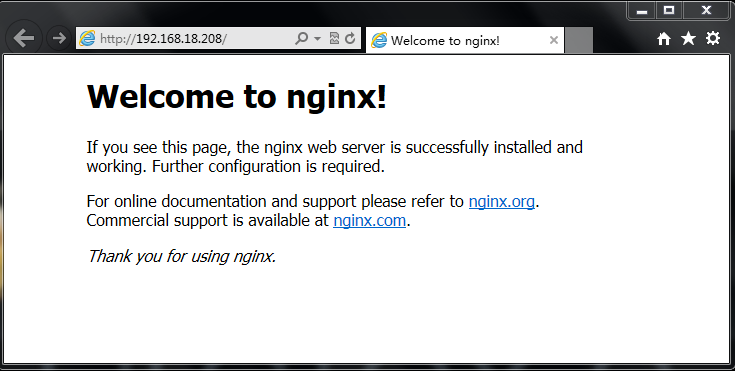














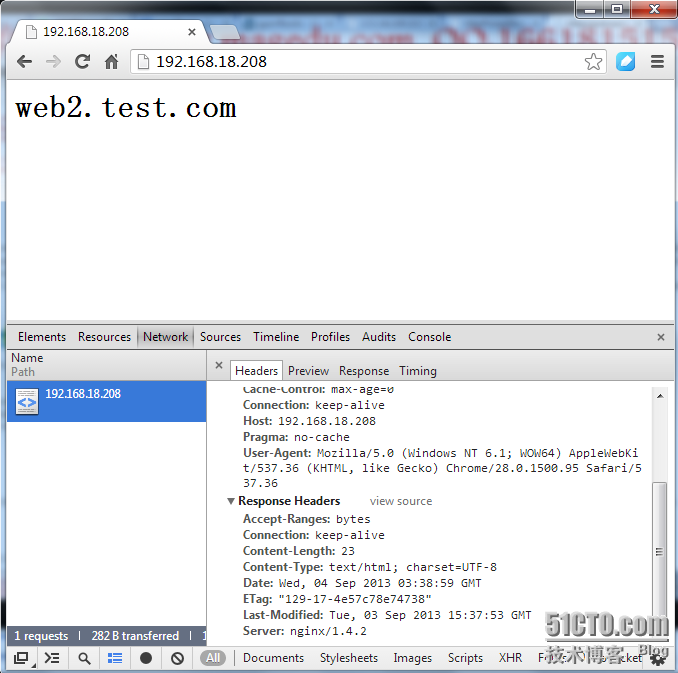
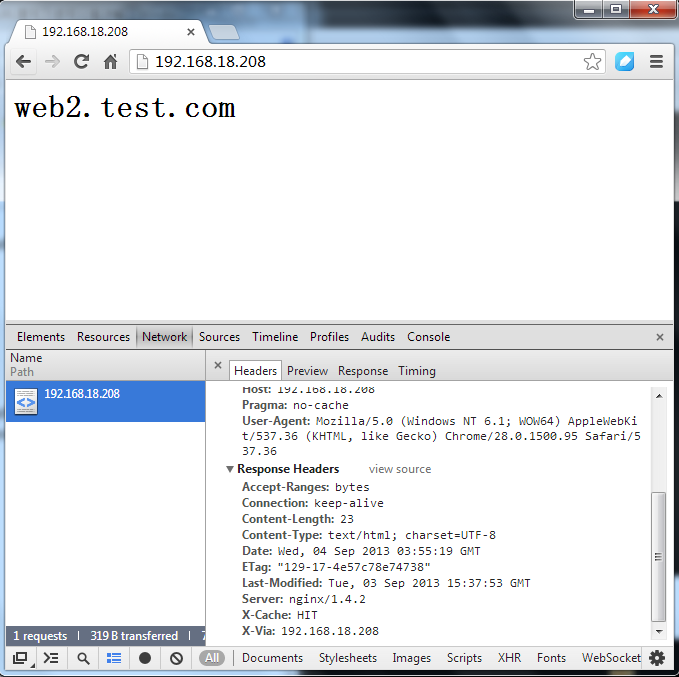

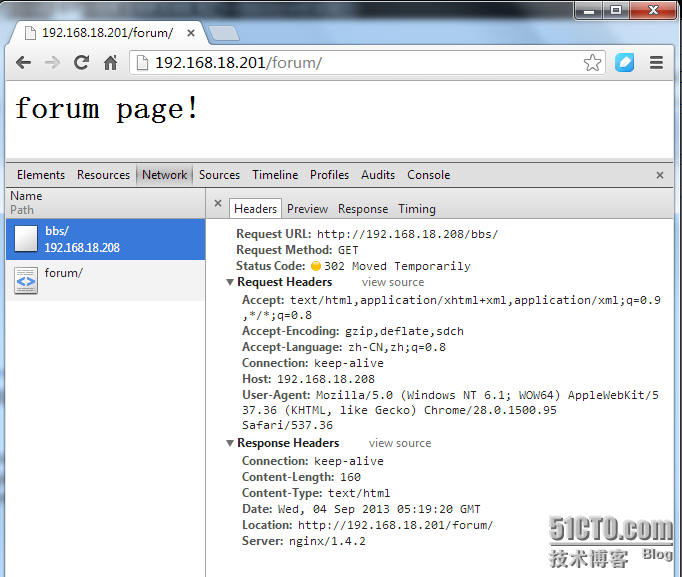
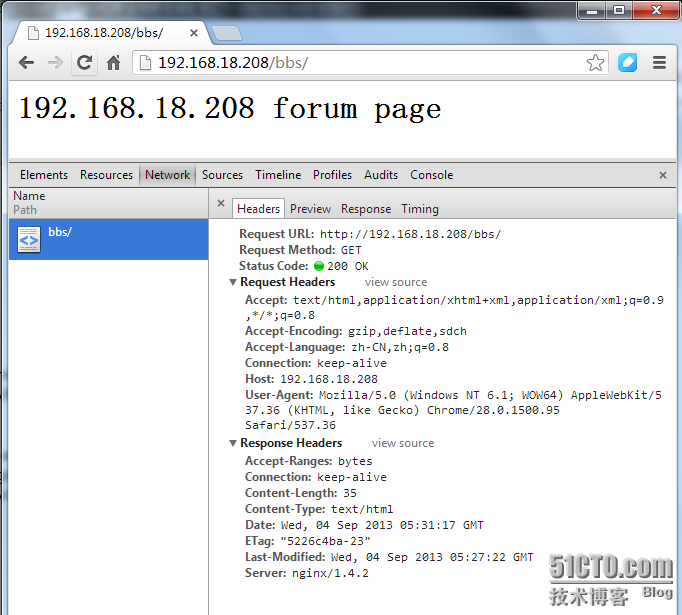





相关推荐
### Nginx 反向代理、负载均衡、页面缓存、URL重写及读写分离详解 #### 一、前言 Nginx是一款广泛使用的高性能HTTP和反向代理Web服务器,也是邮件代理服务器,并具有IMAP/POP3/SMTP服务。Nginx以其稳定性、丰富的...
### Nginx_反向代理、负载均衡、页面缓存、URL重写及读写分离详解 #### 一、前言 Nginx是一款广泛使用的高性能HTTP和反向代理Web服务器,也是常用的邮件代理服务器。它以其高稳定性、丰富的功能集、简单的配置方式...
在Django应用中,为了处理高并发,除了负载均衡,还需要考虑其他优化措施,如数据库优化(如使用缓存、读写分离)、异步任务处理(如Celery)、静态文件分离以及代码优化等。同时,监控系统也是必不可少的,它可以...
- **负载均衡策略**:Nginx支持多种负载均衡策略,如轮询、权重、最少连接数等,确保服务器间的负载均衡。 4. **URL路由与重写** - **location匹配**:通过location指令,Nginx可以根据请求的URL进行精确或模糊...
### 四、Nginx缓存策略 Nginx可以作为静态资源服务器,也可以作为缓存服务器,减少对后端应用服务器的压力。`proxy_cache_path`指令用于定义缓存目录,`proxy_cache`指令启用缓存。 ```nginx http { proxy_cache_...
Nginx 可以将请求转发到后端服务器,并可以根据策略进行负载均衡,如轮询、最少连接数等。 **5. 动态模块加载** 从 Nginx 1.9.11 版本开始,引入了动态模块加载功能。在 `src/core/ngx_modules.c` 中,Nginx 会...
1. **数据库代理**:Nginx作为数据库的代理,可以实现读写分离、负载均衡等功能。 2. **安全防护**:作为边界防火墙的一部分,TCP代理可以过滤恶意流量,保护内部服务器。 3. **API网关**:对于非HTTP的API接口,...
它在静态文件服务、负载均衡、缓存等方面表现出色,是许多大型网站和应用的首选Web服务器。Nginx的工作模式是基于非阻塞I/O多路复用模型(例如epoll或kqueue),这使得它在资源利用上非常高效。 **二、Lua** Lua是...
在 Linux 系统中,尤其是 CentOS 7,Nginx 被广泛用于网站托管和负载均衡。本资源提供的是 Nginx 的 1.24.0 版本,它是一个预编译好的二进制包,无需进行编译安装,简化了部署流程。 **安装与部署** 1. 首先,将...
2. **负载均衡**:Nginx支持基于多种策略的负载均衡,如轮询、权重、最少连接数等,可以有效分散请求到多个后端服务器,提高服务的响应速度和可用性。 3. **静态内容处理**:Nginx对静态资源(如HTML、图片、CSS、...
- **集群原理**:通过LVS或Nginx等负载均衡器将请求分发到多个Tomcat实例上。每个Tomcat实例负责处理一部分请求,通过会话复制或集中式缓存等方式实现会话共享。 - **会话管理**:使用如Memcached或Redis等缓存技术...
在构建大型网站时,Web服务器缓存是一种至关重要的优化策略,它可以显著提高系统性能和响应速度,降低服务器负载。本文将深入探讨四种主要的缓存技术:CDN缓存、反向代理缓存、应用程序缓存和分布式缓存,以及讨论...
- 架构层面:采用缓存、负载均衡等技术手段。 - 硬件层面:增加服务器数量、升级硬件配置等。 通过本教程的学习,开发者不仅可以掌握SpringMVC、Mybatis、Redis、Solr、Nginx等关键技术,还能够深入了解如何运用...
通过对 Nginx 的深入了解,我们可以看到它不仅是一款优秀的 Web 服务器,而且还是一个强大的负载均衡器和缓存解决方案。通过合理的配置和优化,Nginx 能够在提高性能的同时降低系统的运维成本。无论是初学者还是高级...
该框架的核心组件包括Nginx作为负载均衡器、Keepalived实现高可用性、Apache作为后端服务器、MySQL集群用于数据管理以及Memcached作为缓存服务。 #### 二、负载均衡与高可用性 - **Nginx**:作为主负载均衡器,能够...
在实际应用中,lua-nginx-module常被用于实现动态负载均衡、细粒度的访问控制、内容生成、日志处理等场景。例如,可以根据实时的后端服务器状态动态调整负载均衡策略;通过Lua脚本检查用户权限,实现精细化的访问...
- **负载均衡**:通过Nginx实现服务的负载均衡,提高系统的可用性和扩展性。 - **前后端分离**:前端采用HTML等技术,后端则使用Spring Boot + MyBatis处理业务逻辑。 综上所述,《Springboot + Mybatis+Dubbo+...